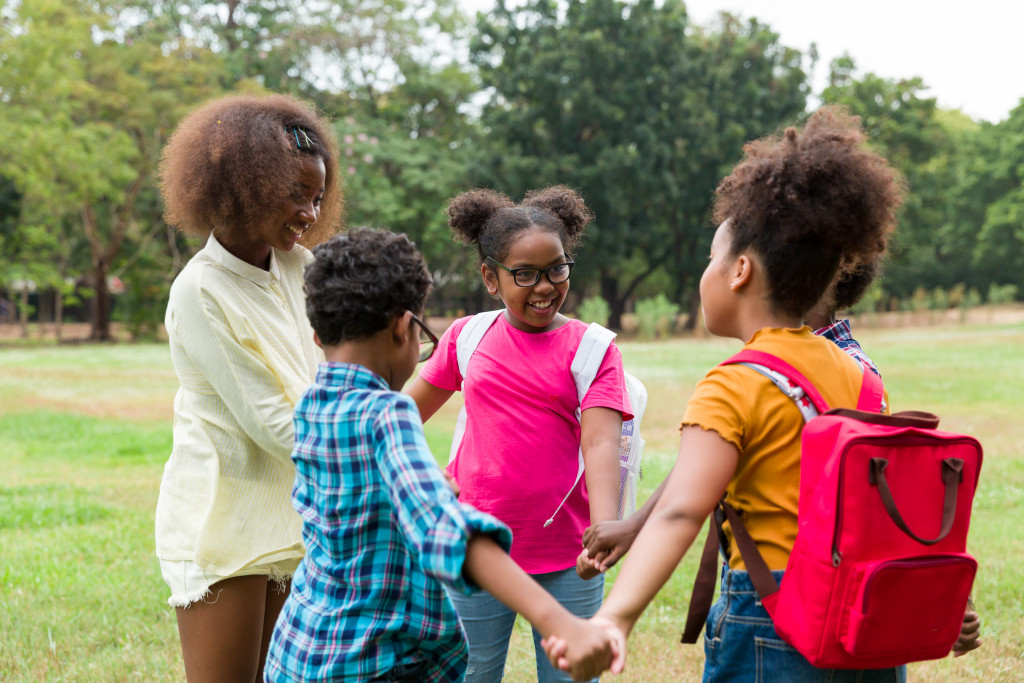- Community involvement provides opportunities for young children to increase their learning and growth.
- Communities provide positive role models that children can emulate.
- Living in a diverse community exposes children to different cultures, beliefs, languages, and ways of life.
- Children thrive when given a chance to contribute and positively feel like active community members.
- Part of a community allows children to form positive relationships with others and to develop social cues, negotiation, and conflict-resolution skills.
As human beings, people are social creatures who thrive on connection and community. This is particularly true for young children in the early stages of developing emotional well-being, social skills, and a sense of self. Explore below why community is so essential for the healthy development of young children and how you can foster a sense of community in your child’s life.
Increased Opportunities for Learning and Growth
Children are the future, and it is up to us to nurture and support their growth. Parents and educators are essential in this process but are not the only ones. Communities also play a crucial role in providing children opportunities for learning and growth.
Role-Modeling
Children learn best through modeling behaviors they see around them. Communities can provide positive role models that children can emulate. Children develop invaluable social skills by interacting with people with varied life experiences, attitudes, and problem-solving approaches.
Increased Exposure
Living in a diverse community exposes children to different cultures, beliefs, languages, and ways of life. This diversity of experiences enriches children’s perspectives and widens their scope of understanding. Exposure to other forms of art, music, and performances can encourage children to explore their creative side and lead to the discovery of their hidden talents.
Opportunities for Active Participation

Lastly, communities allow young children to be actively involved in their environment. Children thrive when given a chance to contribute and positively feel like active community members.
There are many ways to give opportunities for active participation. Whether it’s helping out in a local park or going to community events, these activities give children a chance to make friends and develop social skills while also contributing to the well-being of their community. Many local schools also organize special events involving children in the community; one great example is educational summer programs. These programs allow children to explore their passions while positively engaging with their peers. Children can learn new skills through summer programs, stay active, and develop a sense of belonging.
Social and Emotional Development
Being part of a community provides opportunities for children to form positive relationships with others. They learn to interact with others appropriately, share their thoughts and express themselves. Community participation also helps children learn social cues, negotiation, and conflict-resolution skills. Children that are engaged with others tend to have better self-esteem, greater self-awareness, and emotional intelligence.
Safety and Security
Parents, caregivers, schools, law enforcement, and the community all play a role in ensuring that children grow up in a safe and secure environment. Here’s how communities play a vital role in keeping our children safe and the steps we can take to ensure that we work together to make our communities safe.
Creating Safer Spaces for Children
The first step in keeping children safe is creating safer spaces for them. Schools, recreation centers, libraries, and other public places should be designed with child safety in mind. Communities should work together to ensure children have a safe and secure environment to grow, learn, and play.
Awareness of Potential Threats
Child predators do exist, and communities must be aware of the potential threats that their children may face. Parents and caregivers can educate themselves and their children about the risks and warning signs associated with child predators. Schools can also teach children about personal safety, and law enforcement can work with community organizations and schools to create child safety programs.
Building Values and Faith

Community plays a vital role in developing a child’s faith and values. Exposure to different belief systems, religious practices, and values allows the child to explore and develop their values. It’s essential to note that this is not limited to religious beliefs. A community that stands by specific matters, such as charity work, opens up similar opportunities to spark good deeds and instills the importance of empathy and gratitude.
Final Thoughts
The famous African proverb goes, “It takes a village to raise a child,” and there’s no denying the importance of community when raising healthy and happy young children. Whether through childcare, school, religious organizations, or local community groups, the community offers many benefits that contribute to children’s social, emotional, and cognitive well-being. As parents and caregivers, it’s our job to nurture and foster a sense of community within our children’s lives, creating safe, loving, and inclusive spaces that they can thrive in.

